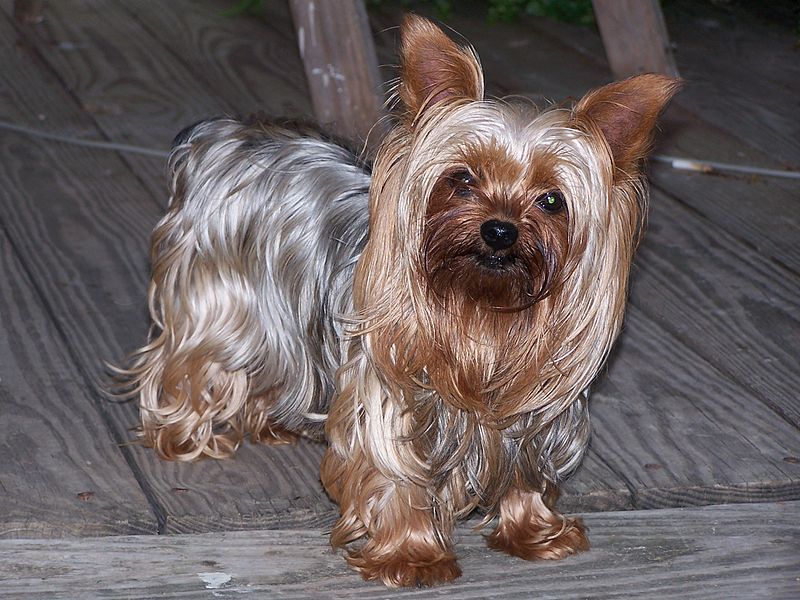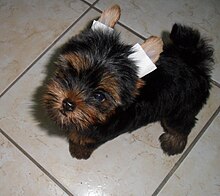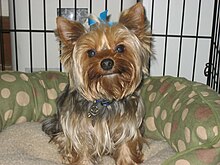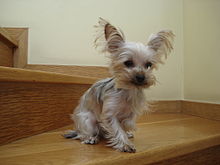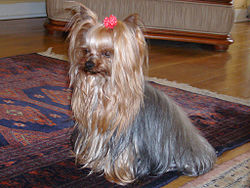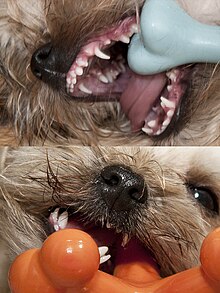
The
Yorkshire Terrier is a small
dog breed of
terrier type, developed in the 19th century in the county of
Yorkshire,
England
to catch rats in clothing mills. The defining features of the breed are
its size, 3 pounds (1.4 kg) to 7 pounds (3.2 kg), and its silky blue
and tan coat. The breed is nicknamed
Yorkie and is placed in the Toy Terrier section of the Terrier Group by the
Fédération Cynologique Internationale and in the Toy Group or
Companion Group by other kennel clubs, although all agree that the breed is a terrier. A popular
companion dog, the Yorkshire Terrier has also been part of the development of other breeds, such as the
Australian Silky Terrier.
Coat
For adult Yorkshire Terriers, importance is placed on coat colour, quality, and texture.
[1]
The hair must be glossy, fine, straight, and silky. Traditionally the
coat is grown-out long and is parted down the middle of the back, but
"must never impede movement."
[2]
From
the back of the neck to the base of the tail, the coat should be a dark
gray to a steel-blue, and the hair on the tail should be a darker blue.
On the head, high chest, and legs, the hair should be a bright, rich
tan, darker at the roots than in the middle, that shades into a lighter
tan at the tips. Also, in adult dogs, there should be no dark hairs
intermingled with any of the tan coloured fur.

A Yorkshire Terrier puppy, 4 weeks old, displaying the characteristic black/steel black and tan coat.
Adult
Yorkshire Terriers that have other coat colours than the above, or that
have woolly or extra fine coats, are still Yorkshire Terriers. The only
difference is that atypical Yorkshire Terriers should not intentionally
be bred.
[3] In addition, care may be more difficult for "woolly" or "cottony" textured coats, or coats that are overly fine.
[1]
One of the reasons given for not breeding "off-coloured" Yorkies is
that the colour could be a potential indicator of a genetic defect that
may affect the dog's health, a careful health screening can clarify if
any health risks exist.
Puppy coats
A
newborn Yorkshire terrier puppy is born black with tan points on the
muzzle, above the eyes, around the legs and feet and toes, the inside of
the ears, and the underside of the tail. Occasionally Yorkies are born
with a white "star" on the chest or on one or more toes. It is also
common to find white patch on one or more nails.
[5] These markings fade with age, and are usually gone within a few months.
It may take three years or more for the coat to reach its final colour. The final colour is usually a blue/grayish colour.
[6]
P. H. Combs, writing in 1891, complained about show wins awarded to
puppies, when the dog's coat does not fully come in until three or four
years old, "and the honor of winning such a prize (for a puppy) can
therefore be of but little practical benefit to the owner" since the
adult dog's color cannot be exactly predicted.
[7]
Hypoallergenic coats
The typical fine, straight, and silky Yorkshire Terrier
coat has also been listed by many popular dog information websites as being
hypoallergenic.
In comparison with many other breeds, Yorkies do not shed to the same
degree, only losing small amounts when bathed or brushed. All dogs shed,
[8] and it is the dog's dander and saliva that trigger most allergic reactions.
[9]
Allergists do recognize that at times a particular allergy patient will
be able to tolerate a particular dog, but they agree that "the luck of
the few with their pets cannot be stretched to fit all allergic people
and entire breeds of dogs."
[10] The Yorkshire Terrier coat is said to fall out only when brushed or broken, or just said to not shed.
[11]
Although neither of those statements agree with what biologists,
veterinarians, and allergists know about dog fur, allergists "think
there really are differences in protein production between dogs that may
help one patient and not another",
[10] meaning that some allergic people may not have allergic reactions to a specific dog, like the Yorkie.
Coat care

Owners may trim the fur short
for easier care. For shows, the coat is left long, and may be trimmed
to floor length to give ease of movement and a neater appearance. Hair
on the feet and the tips of ears can also be trimmed.
[1][2]
The traditional long coat is extremely high maintenance. To prevent
breakage, the coat may be wrapped in rice paper, tissue paper, or
plastic, after a light oiling with a coat oil. The oil has to be washed
out once a month and the wraps must be fixed periodically during the
week to prevent them from sliding down and breaking the hair. Elaborate
coat care dates from the earliest days of the breed. In 1878, John Walsh
described similar preparations: the coat is "well greased" with coconut
oil, the dog is bathed weekly, and the dog's feet are "carefully kept
in stockings."
[12]
Yorkshire Terrier with two toned coat
One year old male Yorkshire Terrier
Other colours
A two year old silver blue and pale cream Yorkshire Terrier

The Yorkshire Terrier is a tan dog
with a blue saddle. Particolors exist, although they are not correct
for the breed standard. The particolor coat is white with black/blue and
tan. It is very rare to get a particolor, and if one is found, it tends
to be very expensive.
[13] Some Yorkshire Terriers are liver or chocolate, a brown colour; they are unable to produce black pigment.
[14]
The breed is defined by its colour, and such non-standard colours may
indicate health problems or cross-breeding with other breeds of other
colours.
[4]
The AKC registration form for Yorkshire Terriers allows for four
choices: blue and tan, blue and gold, black and tan, black and gold.
Colour alone will not affect whether or not a dog is a good companion
and pet. Even though off-coloured Yorkshire Terriers are advertised at
premium prices, being of an unusual or untypical colour is neither new,
desirable, nor exotic.

A three year old Yorkshire Terrier, displaying a black and tan coat.
Until
recently, mismatched Yorkshire Terriers could be crossed with Biewer
terriers, a new breed originated in Germany from party coloured
Yorkshire Terriers.
[15]
Although the American Kennel Club will not deny registration of a
Yorkshire Terrier on colour alone, the Yorkshire Terrier Club of America
has a directive that "any solid colour or combination of colours other
than blue and tan" for adult dogs is a disqualification, and "dogs of
solid colour, unusual combination of colours, and party-colours should
be disqualified."
[6]
Temperament
The
ideal Yorkshire Terrier character or "personality" is described with a
"carriage very upright" and "conveying an important air."
[2]
Though small, the Yorkshire Terrier is active, loves attention, very
overprotective and should not show the soft temperament seen in
lap dogs.
Yorkshire Terriers, also known as Yorkies, are a little harder to train
than some other breeds of dogs. This results from their own nature to
work without human assistance.
Yorkshire terriers tend to bark a
lot. This makes them excellent watch dogs because they will sound the
alarm when anyone gets near. This barking problem can be resolved with
proper training.
History

Three year old with characteristic long hair
The Yorkshire Terrier originated in
Yorkshire (and the adjoining
Lancashire), a rugged region in northern England.
[16]
In the mid-19th century, workers from Scotland came to Yorkshire in
search of work and brought with them several different varieties of
small terriers. Breeding of the Yorkshire Terrier was "principally
accomplished by the people—mostly operatives in cotton and woolen
mills—in the counties of Yorkshire and Lancashire."
[17]
Details are scarce. Mrs. A. Foster is quoted as saying in 1886, "If we
consider that the mill operatives who originated the breed...were nearly
all ignorant men, unaccustomed to imparting information for public use,
we may see some reason why reliable facts have not been easily
attained."
[18]
What
is known is that the breed sprang from three different dogs, a male
named Old Crab and a female named Kitty, and another female whose name
is not known.
[19] The
Paisley Terrier, a smaller version of the
Skye Terrier that was bred for a beautiful long silky coat, also figured into the early dogs. Some authorities believed that the
Maltese was used as well.
[20]
"They were all originally bred from Scotch terriers (note: meaning dogs
from Scotland, not today's Scottish Terrier) and shown as such...the
name Yorkshire Terrier was given to them on account of their being
improved so much in Yorkshire."
[18]
Yorkshire Terriers were shown in a dog show category (class) at the
time called "Rough and Broken-coated, Broken-haired Scotch and Yorkshire
Terriers". Hugh Dalziel, writing in 1878, says that "the classification
of these dogs at shows and in the Kennel Club Stud Book is confusing
and absurd" in lumping together these different types.
[21]
In
the early days of the breed, "almost anything in the shape of a Terrier
having a long coat with blue on the body and fawn or silver coloured
head and legs, with tail docked and ears trimmed, was received and
admired as a Yorkshire Terrier".
[17] But in the late 1860s, a popular Paisley type Yorkshire Terrier show dog named
Huddersfield Ben,
owned by a woman living in Yorkshire, Mary Ann Foster, was seen at dog
shows throughout Great Britain, and defined the breed type for the
Yorkshire Terrier.
[22]
Yorkshire Terriers -Mrs. Fosters "Huddersfield Ben" and Lady Giffard's "Katie" c. 1870
Huddersfield Ben
Huddersfield Ben was a famous dog. His portrait was painted by
George Earl[23]
and in 1891 an authority on the breed wrote, "Huddersfield Ben was the
best stud dog of his breed during his life-time, and one of the most
remarkable dogs of any pet breed that ever lived; and most of the show
specimens of the present day have one or more crosses of his blood in
their pedigree."
[24]
A show winner, Huddersfield Ben quickly became the type of dog everyone
wanted, and through his puppies has defined the breed as we know it
today. He is still referred to as "father of the breed."
[22]
In North America
The Yorkshire Terrier was introduced in North America in 1872
[16] and the first Yorkshire Terrier was registered with the American Kennel Club (AKC) in 1885.
[25] During the
Victorian era,
the Yorkshire Terrier was a popular pet and show dog in England, and as
Americans embraced Victorian customs, so too did they embrace the
Yorkshire Terrier.
[26]
The breed's popularity dipped in the 1940s, when the percentage of
small breed dogs registered fell to an all-time low of 18% of total
registrations.
[27] Smoky, a Yorkshire Terrier and famous war dog from World War II, is credited with beginning a renewal of interest in the breed.
[28]
Health
A
number of health issues, some of them hereditary, have been found in
individual Yorkshire Terriers, and are listed below. There is no data on
the percentage of dogs with these ailments, and it is not suggested
that all Yorkshire Terriers have all of these ailments, or that any
particular dog has any of these ailments. Puppy buyers are advised to
ask breeders if tests have been done for these diseases.
Morbidity
Health issues often seen in the Yorkshire Terrier include
bronchitis,
lymphangiectasia,
portosystemic shunt,
cataracts, and
keratitis sicca. Additionally, injection reactions (inflammation or hair loss at the site of an injection) can occur.
[29] In addition they may have skin allergies.
Teeth

Morkie (half Maltese, half Yorkie) puppy with his deciduous teeth and adult teeth growing in
As
with all other dogs, Yorkies have two sets of teeth in their life. The
first set of teeth is the 28-piece deciduous teeth (often referred to as
"milk teeth", "baby teeth" or "puppy teeth"). The second set is the
42-piece permanent or adult teeth. Sometimes the number of permanent or
adult teeth may vary, which is fine as long as they do not cause bad
bite. When puppies are born, they have no teeth because milk is the only
food they need. The deciduous teeth will grow from the age of 3 to 8
weeks old, in the order of incisors, canine/ fangs and premolars. Yorkie
puppies have no molar teeth. Yorkie puppies will start to lose their
deciduous or baby teeth when the permanent or adult teeth come in. The
permanent or adult grow when the Yorkie puppies are 4 to 8 months old.
By around 8 months old, those teeth should fully develop. The permanent
or adult teeth will grow in the order of incisors, canine/fangs,
premolars and molars. Molar teeth will develop at around 6 to 8 months
old.
[30]
Yorkies
and other small dog breeds may have problems if the deciduous or baby
teeth do not fall out as the permanent or adult teeth grow. This is
caused by the new teeth not growing right underneath the deciduous
teeth. (Usually, a puppy’s body will absorb the roots of puppy teeth.)
If the puppy tooth does not yield to the incoming tooth, it should be
removed because it can cause a malocclusion or bad bite.
[31]
Retained teeth can cause tooth decay because food can be easily caught
in between the deciduous and permanent teeth. Sometimes the new teeth
are forced to grow into an abnormal position and further cause a bad
bite. The retained teeth may stay or fall weeks after the new teeth have
developed. When necessary, the retained deciduous or baby teeth need to
be removed surgically.
[32]

Yorkie's retained deciduous or baby fangs.
Like
other small breeds, Yorkies are also prone to severe dental disease.
Because they have a small jaw, their teeth can become crowded and may
not fall out naturally. This can cause food and plaque to build up, and
bacteria can eventually develop on the surface of the teeth, leading to
periodontal disease. In addition, the bacteria can spread to other parts
of the body and cause heart and kidney problems. The best prevention is
regular brushing of the teeth with a toothpaste formulated specifically
for dogs. Human toothpaste is not recommended, because it foams easier
and may be swallowed. Professional teeth cleaning by a veterinarian may
also be required to prevent the development of dental problems.
[33]
Genetic defects
Certain
genetic disorders have been found in Yorkshire Terriers, including
distichiasis,
hydrocephalus,
hypoplasia of dens,
Legg–Calvé–Perthes syndrome,
luxating patella,
portosystemic shunt,
retinal dysplasia,
tracheal collapse, and
bladder stones.
[34] The following are among the most common
congenital defects that affect Yorkies.
- Hypoplasia of dens is a non-formation of the pivot point of the second cervical vertebra, which leads to spinal cord damage.[34] Onset of the condition may occur at any age, producing signs ranging from neck pain to quadriplegia.[29]
- Legg–Calvé–Perthes syndrome, which causes the top of the femur (thigh bone) to degenerate, occurs in Yorkies in certain lines.[37] The condition appears to result from insufficient circulation to the area around the hip joint. As the blood supply is reduced, the bone in the head of the femur collapses and dies and the cartilage coating around it becomes cracked and deformed.[37]
Usually the disease appears when the Yorkie is young (between five and
eight months of age); signs are pain, limping, or lameness.[38] The standard treatment is surgery to remove the affected part of the bone.[38]
Following surgery, muscles hold the femur in place and fibrous tissue
forms in the area of removal to prevent bone rubbing on bone.[39] Although the affected leg will be slightly shorter than prior to surgery, the Yorkie may regain almost normal use.[38]
- Luxating patellas (slipping kneecaps) are another common defect considered to be genetic in Yorkies, although it may also be caused by an accidental fall. Weak ligaments and tendons in the knee or malformed (too shallow) patellar grooves, allow the patella to slip out of its groove sideways.[40] This causes the leg to 'lock up' with the foot held off the ground.[40]
A dog with this problem may experience frequent pain and lameness or
may be bothered by it only on occasion. Over time, the patellar ridges
can become worn down, making the groove even more shallow and causing
the dog to become increasingly lame.[40]
Surgery is the main treatment option available for luxating patellas,
although it is not necessary for every dog with the condition.
- Portosystemic shunt, a congenital malformation of the portal vein (which brings blood to the liver
for cleansing), is also common in Yorkies. In this condition some of
the dog's blood bypasses the liver and the "dirty" blood goes on to
poison the heart, brain, lungs, and other organs
with toxins. A Yorkie with this condition might exhibit a wide variety
of symptoms, such as small stature, poor appetite, weak muscle
development, decreased ability to learn, inferior coordination,
occasional vomiting and diarrhea, behavioral abnormalities, seizures (especially after a meal), and blindness, which could lead to a coma and death. Often, the shunt can be treated with surgery.
- Tracheal collapse, caused by a progressive weakening of the walls of the trachea, occurs in many toy breeds, especially very tiny Yorkies.[41] As a result of genetics, the walls of the trachea can be flaccid, a condition that becomes more severe with age. Cushing's syndrome, a disorder that causes production of excess steroid hormone by the adrenal glands, can also weaken cartilage and lead to tracheal collapse.[42]
There is a possibility that physical strain on the neck might cause or
contribute to trachea collapse. Since this is usually caused by an
energetic Yorkie pulling against his collar, many veterinarians
recommend use of a harness for leashed walks.[41] An occasional "goose honking" cough, especially on exertion or excitement, is usually the first sign of this condition.[41]
Over time, the cough may become almost constant in the Yorkie's later
life. Breathing through the obstruction of a collapsed (or partially
collapsed) trachea for many years can result in complications, including
chronic lung disease. The coughing can be countered with cough suppressants and bronchodilators.[41] If the collapse is advanced and unresponsive to medication, sometimes surgery can repair the trachea.[41]
Hypoglycemia
Low blood sugar in puppies, or
transient juvenile hypoglycemia, is caused by fasting (too much time between meals).
[43]
In rare cases hypoglycemia may continue to be a problem in mature,
usually very small, Yorkies. It is often seen in Yorkie puppies at 5 to
16 weeks of age.
[43] Very tiny Yorkie puppies are especially predisposed to hypoglycemia because a lack of muscle mass makes it difficult to store
glucose and regulate blood sugar.
[43]
Factors such as stress, fatigue, a cold environment, poor nutrition,
and a change in diet or feeding schedule may bring on hypoglycemia.
[44] Low blood sugar can also be the result of a
bacterial infection,
parasite, or portosystemic liver shunt.
[45] Hypoglycemia causes the puppy to become drowsy, listless (glassy-eyed), shaky, uncoordinated, since the
brain relies on sugar to function. During a hypoglycemic attack, the puppy usually has very pale or grey gums.
[46] The puppy also may not eat unless force-fed.
[43]
Hypoglycemia and dehydration seem to go hand-in-hand, and force-feeding
or injecting fluids may also be necessary. Additionally, a hypoglycemic
Yorkie may have a lower than
normal body temperature and, in extreme cases, may have a
seizure or go into a
coma.
[47] A dog showing
symptoms should be given sugar in the form of corn syrup or NutriCal and be treated by a
veterinarian immediately, as prolonged or recurring attacks of hypoglycemia can permanently damage the dog's brain.
[47] In severe cases it can be fatal.
[43]
Mortality
The
life span
of a healthy Yorkie is 12–17 years. Extremely under-sized Yorkies (3
pounds or less, and often promoted as "Teacups") generally have a
shorter life span (3–7 years on average),
[48] as they are especially prone to health problems such as chronic
diarrhoea and
vomiting and are more easily injured.
[35] Even the normal small size of a Yorkshire Terrier means that it can have a poor tolerance for
anesthesia, and it is more likely to be killed or injured by falls, other dogs, and owner clumsiness.
[35]
Docking
Traditionally, the Yorkshire Terrier's tail is
docked to a medium length.
[48]
Opposition to this practice began very early in the history of the
breed; Hugh Dalziel, writing about Yorkshire Terriers in 1878, declared
that "There is no reason for mutilating pet dogs, and perfect ears and
tails should be bred, not clipped into shape with scissors."
[21] Often, a Yorkshire Terrier's
dewclaws, if any, are removed in the first few days of life,
[1] another controversial practice.
Similar breeds and crosses
The Yorkshire Terrier breed descends from larger but similar Scottish breeds such as the now extinct
Paisley Terrier and the
Skye Terrier. In its turn, other breeds have been created from the Yorkshire Terrier, such as the
Australian Silky Terrier
and the Biewer Terrier, bred from a blue, white, and gold puppy they
later named Schneeflocken von Friedheck, by Mr. and Mrs. Biewer of
Germany.
[49]
Demand for unusual pets has resulted in high prices being paid for
Yorkshire Terriers crossed with various other breeds, which are
described with a
portmanteau word made up of
syllables (or sounds) from Yorkshire Terrier and the breed name of the other parent. A list of such portmanteau-named
crosses can be found on the
List of dog hybrids page.

